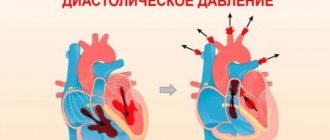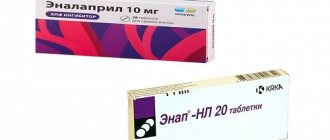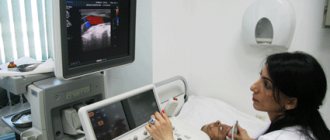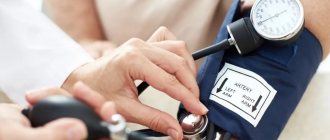Blood pressure indicators are among the main physical parameters by which the state of the vascular system and human health in general are judged. The heart pumps a certain volume of blood per unit of time. The pressure it creates on the walls of blood vessels is highest at the exit from the left ventricle and decreases as it moves further. Minimum values are recorded in the veins and capillaries. Ideal figures for upper and lower pressure are calculated depending on gender and age. Significant deviations from the norm indicate life-threatening conditions: hypertension, hypoxia or heart failure.
What is systolic and diastolic pressure
The pushing of blood into the aorta by the contracting heart muscle is called the systole phase. The resistance that is created on the walls of the main artery is systolic or upper pressure. The indicator recorded in the myocardial relaxation phase is lower or diastolic. It is always lower than the previous one, systolic. Write down these values accordingly, separated by a line: 120/80, 130/90, etc.
Many consider the only normal blood pressure indicator to be 120/80 mmHg, believing that the slightest deviation from it is a sign of the development of vascular diseases. Others do not pay attention to the numbers of tonometers at all; they measure pressure extremely rarely, only during annual medical examinations. A common misconception: changes in indicators immediately make themselves known with negative symptoms. In fact, even long-term deviations from the norm rarely lead to disturbances in well-being, especially at the initial stage of hypertension. This circumstance is the main reason that the pathology often starts, and patients turn to doctors already at the second or third stage.
Healthy people are also likely to experience fluctuations in blood pressure. Indicators may vary slightly during the day: in the morning and evening they are slightly lower than at the height of the day. Blood pressure is affected by habits and lifestyle, food and drinks consumed. Within the normal range, it periodically decreases or increases to 10 units. Many feel great with stable indicators that deviate more significantly from the generally accepted ones. For these reasons, in medicine there is a concept of “working” pressure for adults. This is a vascular condition in which a person does not experience a deterioration in health, and the body remains healthy. Stable blood pressure readings may vary:
- for systolic: from 100 to 140;
- for diastolic: from 60 to 90.
A further decrease or increase in numbers already indicates the development of pathologies.
Conclusion
The optimal difference between systolic and diastolic pressure is 70
is 40 mmHg. But a slight deviation of 10 units up or down is also within acceptable limits.
blood pressure prevention
If the pressure changes by 20 more or less, and you feel normal, most likely there was an incorrect pressure measurement. If your health really gets worse, you should immediately consult a doctor.
In case of difference between systolic and diastolic pressure
is sixty or more, this is the risk of developing heart and vascular diseases. In this case, you must constantly consult your doctor. To make an appointment with our specialist, leave a request on the website or call.
Changes in blood pressure by age
It is a mistake to think that blood pressure control is only necessary for older people. Diseases associated with its violation can develop at any age. In order not to miss them, it is recommended to monitor blood pressure levels regularly from the first years of life. At the same time, it is important to remember that its standards are different for children and adults. Their range:
- in newborns: from 75/50 to 105/75
- aged 1–5 years: from 80/55 to 110/79
- for 6–15 year olds: from 90/60 to 110/80
- for 16–24 years old: from 110/70 to 132/80
- for 25–39 years: from 110/70 to 135/86
- for 40–59 years: from 111/78 to 139/88
- for 60 years and older: from 116/80 to 147/90
Low rates in infants and children under 1 year of age are explained by imperfections in the vascular system. Their arteries are not elastic enough, and the network of capillaries is dense. As you grow older, the body's tone increases, and the range of blood pressure fluctuations becomes smaller. In children over 5 years of age, blood pressure increases more slowly, reaching the lower limit of the adult normal range by adolescence.
During school years, due to sharp jumps in growth and development, more frequent changes in indicators are possible, including throughout the day. If the condition is not accompanied by poor health, there is no need to worry. An increase of 20 mm or more should cause alarm. In these cases, correction of the daily routine and consultation with a therapist, endocrinologist and cardiologist are required.
Another category of people in whom significant changes in blood pressure are considered normal are pregnant women. Changes in hormonal levels and increased workload inevitably affect the functioning of blood vessels and internal organs. During this period, indicators should be monitored regularly. Their departure from the age norm is a reason for additional consultations with a doctor.
Regulatory data
The level of blood pressure, diastolic and systolic, is influenced by:
- general condition of the body's blood vessels;
- gender;
- patient's age;
- stressful situations;
- overwork;
- physical exercise;
- a certain way of life.
The difference between the two is related to the physiological processes taking place in the human body. Contraction of the heart muscle provokes a blood discharge that affects the left ventricle. Subsequently, as the blood moves through the arteries, capillaries and veins, the blood pressure level gradually decreases. As the flow returns back to the heart, it will be minimal.
Table of normal indicators:
| Blood pressure in mm | Diastole in mm | Systole in mm |
| Norm | 80 | 120 |
| Valid values | 81-85 | 121-130 |
| Excess | 86-89 | 131-140 |
| Hypertension 1 st. | 90-100 | 141-160 |
| Hypertension 2 tbsp. | 101-110 | 161-180 |
| Complex hypertension | over 110 | above 180 |
How to measure blood pressure correctly
If there is no reason to doubt your health, it is not necessary to measure your blood pressure daily. But doing this at least twice a month and if your health worsens will not hurt. Morning indicators - immediately after waking up, are considered the most reliable. At this time, the blood flow is stable. Fluctuations in blood pressure are inevitable with sudden movements, after eating, due to nervous and physical stress. You should not take the blood pressure monitor after playing sports or other vigorous activities.
To prevent the indicator numbers from being distorted, it is advisable to take a relaxed position during measurements and not move. It is important to place the tonometer at chest level. When using a mechanical device, do not squeeze the cuff too tightly. The procedure should be repeated on both hands. A deviation of the obtained values by more than 5 mm is a sign of incorrect operation of the device or its incorrect use.
What is the importance of diastolic blood pressure
Diastole refers to an indicator that includes two important factors:
- The first one determines the tension or relaxation of the capillary line. With strong compression, the diastole will be higher, which indicates a malfunction occurring in the cardiovascular department, a high risk of hypertensive syndrome. When the level is reversed, a drop in diastolic blood pressure is observed.
- The second indicates the degree of relaxation of the heart muscle during diastole. If the data is bad, the issue is related to the lack of normal rest and the heart working hard. Regular overloads over time provoke various pathological changes against the background of wear and tear.
Recorded changes should not be ignored. A timely visit to the clinic will allow you to catch the disease in the early stages, avoiding its severe course and many complications.
Consequences of blood pressure disorders
Functional disorders of the heart, kidneys, excess weight, stress, smoking, endocrine and systemic diseases, and atherosclerotic changes in blood vessels lead to a prolonged increase in blood pressure levels. For most people, initial deviations do not cause alarm, but are dangerous for the body. Progressive hypertension is fraught with the development of coronary artery disease, myocardial infarction, and acute cerebrovascular accident.
Regular hypotension - readings below 85/60 lead to insufficient oxygen and nutrition to the tissues. This pathology often occurs due to heart failure, physical exhaustion, and genetic predisposition. Without correction, it can provoke disruption of the central nervous system, hormonal balance, anemia and myocardiopathy.
Features of pulse pressure
The term refers to the difference between systole and diastole. It shows the patency of blood vessels and the general condition of their internal membranes. The ideal difference between the two values should be 60 mmHg; a larger gap in the data indicates vascular spasm or inflammatory processes occurring in the blood vessels.
A greatly reduced level of pulse blood pressure is considered characteristic of certain pathologies, represented by:
- heart failure;
- stroke in the left ventricle of the heart;
- myocardial infarction.
If deviations from standard sizes within 40-55 units are detected, you must consult a cardiologist. The doctor will issue a referral for a laboratory diagnostic examination, and after clarifying the presumptive diagnosis, he will prescribe therapy in accordance with the detected disease.
Example of a self-monitoring diary in Excel
If you have constant access to a computer, then filling out the diary can be slightly automated using Excel. For myself, I chose the first option of the self-monitoring diary, inserted a button into it to add readings, which opens a form with the date and time automatically filled in. If necessary, they can be edited both in the form itself and after recording on the worksheet.
Instructions for filling out a blood pressure self-monitoring diary in Excel:
- Click the “Add” button: a form will open with the date and time already filled in.
- Add the tonometer readings to the appropriate fields.
- “Well-being” and “Note” can be selected from the drop-down list*, filled in yourself, or left blank.
- Click the “OK” button and the data from the form will be written to a new row in the table, and the workbook will be saved.
* You can independently specify what data will be shown in the drop-down lists. To do this, simply edit the cell values in the “Wellness” and “Note” columns on the “LD and Appointments” worksheet. The cells of these columns must be filled from top to bottom without gaps.
In the “Note” column you can write:
- presence of arrhythmia;
- medications taken and their dosage;
- body weight, if it is monitored;
- doctor visits;
- other useful information.
It is convenient to move around the form while recording readings using the “Tab” or “Enter” keys. During the transition, the “Well-being” and “Note” fields are skipped, since they are not always filled out.
Treatment of hypotension
{banner_banstat3}
Both medications and non-drug therapy can be used to raise blood pressure. Medications are prescribed exclusively by a doctor, for which it is necessary to consult a therapist and undergo examination by specialized specialists - a cardiologist, endocrinologist, neurologist.
Experts include drugs that help normalize blood pressure when its level is 70 to 40 (70/50):
- products containing caffeine (Citron, Vasobral);
- anxiolytics (Mebicar, Adaptol);
- nootropics (Piracetam, Aminalon);
- adaptogens of plant origin in tinctures (eleutherococcus, ginseng, lemon balm);
- vitamins, antioxidants.
Excellent results are achieved by prescribing physiotherapeutic procedures - massage, electrotherapy (magnet, electrosleep, electrophoresis), hydrotherapy (contrast shower).
At-risk groups
All elderly people are at risk of developing hypertension due to the natural aging of blood vessels and the heart. At an earlier age, the likelihood of high blood pressure is higher if:
- Diseases of the kidneys and blood vessels.
- Congenital heart defects.
- Obesity.
- Alcohol abuse, smoking.
- Frequent stress, disruption of work and rest schedules.
- Systematic intoxication with harmful substances.
- Eating foods high in cholesterol and salt.
- Diseases of the endocrine system.
People who have had head injuries or heart and brain surgery should also monitor their blood pressure.
Notes and download links
You can download the self-control diary from the link below. The archive offered for downloading contains two files: a diary of self-monitoring of blood pressure and a file with forms of tables of option 1 and option 2 for printing.
The spreadsheets and diary were created in Excel 2021 and saved in Excel 1997-2003 format, so users of Excel 1997-2003 may need to adjust the page layout of the forms for correct printing.
While keeping a diary, I discovered that I never filled out the “Well-being” column. Therefore, in my version of the self-control diary, I replaced the “Well-being” column with the “Pills” column, in which I record the medications taken and their dosage. You can download a blood pressure diary with a “Pills” column from the link below.
Concept of pressure, resistance and heart rate
Take a rubber bulb in your palm and fill it with water. Now squeeze it as hard as you can, trying not to leave a single drop inside. The water will pour out of the outlet, and the larger it is, the less effort you need to make. And vice versa. The narrower the hole, the more difficult it is to squeeze everything out of the pear cavity without leaving a trace. Now we’ll do the same thing, but let’s try to put two rubber bulbs together. Let's fill them with the same volume of water, but in one we will make a large hole for exit, and in the other - a small one. From the first, when compressed, water will pour out easily, with a slight squeeze, but to empty the second, much more force will be required. This is what happens with the heart. With one important exception: there is no one to squeeze him, and his own muscular system does all the work.
Contracting, or “contracting,” in the systole phase, it pushes out of its ventricles all the blood coming from the atria, and in the diastole phase
– rests, gaining strength for the next contraction, which will follow in a split second.
The force with which the heart muscle compresses this volume of blood in the cavity of the ventricles creates pressure, as a result of which the blood is thrown into the great vessels. But the speed with which it leaves the ventricles will depend not only on the force of compression, but also on how difficult or easy it is for it to leave the ventricle and enter the lumen of the vessel. That is, if we return to our two rubber bulbs: it will go through the larger hole, or through the smaller one. In other words, what is also important is what kind of resistance will be provided to this release from the side, so to speak, that receives it, i.e. vascular bed. Here we have come to understand several main laws that govern both the movement of blood in the heart and its movement in the body, i.e. to what forces and along what currents our kayak moved.
So, a few new concepts: blood volume, pressure and resistance to blood flow.
The simplest and long-known most important parameter that can be measured and expressed in numbers is pressure. But what is pressure? Believe me, if you want to understand what’s wrong with your child, you need to know this clearly. Only then will you be able to understand what the doctors will tell you. It's actually very simple.
Blood pressure is a number that speaks about two important aspects of blood movement: its volume and resistance to its flow in each individual period of time. It can be measured in any vessel, in any chamber of the heart. And it gives a fairly accurate idea of what is happening there, inside the chamber, at each phase of the cardiac cycle.
For now we are only talking about the work of a healthy heart. And it is clear that the greater the volume of blood in the ventricle, the greater the effort required to eject it, i.e. put him under more pressure. And - the greater the resistance to ejection, the greater the effort (pressure) needed to empty the ventricle, preparing it for a new portion of blood.
The vascular bed resists blood flow as a whole, from the beginning, i.e. from the ascending aorta, to the smallest arteries and capillaries - in the large circle, and the pulmonary arteries, arterioles and capillaries - in the small circle. Consequently, the powerful left arterial ventricle works against the resistance of the gigantic vascular bed of the entire body. The right ventricle, venous, thinner-walled, works against the same gigantic volume, but much more elastic, short and “soft” vascular bed of the lungs. Accordingly, the pressure figures in the cavities of the ventricles are different, and in the vessels extending from them. These figures are reflected in Table No. 1, and you can see that the pressure under normal conditions in the right ventricle and pulmonary artery is approximately one third of the pressure in the left ventricle and vessels of the systemic circle. Remember that quantity, i.e. The volume of blood ejected from each ventricle with each contraction is normally the same. So far we have only talked about the compression of blood volume under pressure. This is the so-called systolic pressure, or the maximum pressure created in the system at the moment of contraction.
But there is a second number - this is the blood pressure in the vessels during diastole, or a relaxed and filling heart. In this phase, the valves of the aorta and pulmonary artery are closed and, with their integrity, the blood in the vessels is under pressure from the closed system of the vascular bed of the body (in the large circle) and the lungs (in the small circle). Therefore, there are two numbers of pressure - the so-called “upper” (systolic) and “lower” (diastolic) pressure.
Average numbers of normal pressure in the cavities of the heart and large vessels (mm Hg)
| Newborns | Children (1 month – teenagers) | |
| Right atrium | 0 — 3 | 2 — 5 |
| Right ventricle | 35 – 65 | 15 -30 / 2 – 5 |
| Pulmonary artery | 35 – 65 / 20 – 40 | 15 – 30 / 5 – 10 |
| Left atrium | 1 — 4 | 5 – 15 |
| Left ventricle | 70 – 90 | 80 – 130 / 5 – 10 |
| Artery | 80 – 100 / 50- 60 | 90 – 130 / 60 — 90 |
Please note that in newborns the pressure in the right ventricle and pulmonary artery is significantly higher than in children even in the first month of life. This is explained by the fact that the vessels and all 700 million alveoli of the lungs open gradually and are fully ready to receive the entire volume of blood from the right ventricle only a few weeks after birth.
Now let's try to answer the question - what moves the heart, what causes its rhythmic contractions. Believe me, this is also very important.
The rhythmic, sequential, regular cycle of contraction and relaxation of the heart is controlled by electrical impulses. These impulses arise in special cells of the heart muscle, the so-called cells of the conduction system. Foci of large accumulations of these cells are called “nodes”, and their branches running along the muscle fibers are called “conducting paths”. There are two nodes of the conduction system: sinus and atrioventricular, and there are several pathways. The peculiarity of the cells themselves that conduct electrical impulses is that they are capable of being excited and transmitting this excitation much faster than neighboring cells of the working, contracting myocardium, or cardiac muscle. Therefore, they are guides, showing the way to others, understanding faster than others where to go. In a normal heart, the superior sinus node is excited first. The impulse is transmitted along the conductive pathways of the walls of the atria to the lower, atrioventricular node, and then, through thinner pathways, it enters the ventricles, causing their contraction in response - the systole phase. This is followed by a pause period - diastole - and the myocardium prepares to receive a new impulse. The frequency of such impulses is the frequency of the heartbeat and pulse. In newborns - 110-120 beats per minute, in adults much less often - 65-75 beats per minute. These electrical impulses are easily recorded by fairly simple instruments. The recording of the devices is called an electrocardiogram.
We are far from thinking of teaching you how to read it: this is a matter for professionals. We just want to explain what it is and why it is done. An electrocardiogram makes it possible not only to identify disturbances in the normal conduction of impulses, but also to determine which parts of the heart are abnormally enlarged, which are constantly working with increased load, and how they cope with it. If a heart defect is suspected, your child will have this test done many times. It is painless and very informative.
We can only marvel at the incredible perfection of the cardiovascular system, which, despite all its complexity, is surprisingly simple, logical and harmonious. However, it must be absolutely accurately and correctly created. Even small changes in its structure are enough to disrupt this constant, calm and synchronous work.
Quoted from the book by G. E. Falkovsky, S. M. Krupyanko. The heart of a child. A book for parents about congenital heart defects
How to get treatment at the Scientific Center named after. A.N. Bakuleva?
Online consultations
Symptoms of hypertension
Signs of pathology are the following conditions:
- Headache, often in the occipital region. May not respond to analgesics.
- Pulsation in the head, noise in the ears.
- Dizziness may occur with a sudden change in position.
- Decreased visual acuity, darkening of the eyes, sensation of “floaters”.
- Chills, increased sweating, rapid pulse, nausea.
- Nose bleed.
- Redness of the face and ears.
- Feelings of anxiety, restlessness, increased fatigue.
Symptoms may indicate more than just hypertension, but when one or more conditions appear, it is recommended to first measure blood pressure. If the values are higher than normal, consult a therapist or cardiologist.
What causes hypotension?
If you suddenly change your body position
Get up quickly or, for example, sit up sharply in bed. This is called orthostatic hypotension. When a person assumes a vertical position, blood, under the influence of gravity, rushes to the legs and abdominal area, and the pressure in the vessels drops. In order to raise blood from the legs and normalize blood pressure, the autonomic nervous system increases the heart rate and constricts blood vessels.
Healthy people do not experience discomfort, since this mechanism works very quickly. But in some cases, the autonomic nervous system fails. As a result, the pressure drops, the blood does not have time to rise from the legs, the brain lacks oxygen, and symptoms of hypotension appear. This happens, for example, in pregnant women, in people with certain diseases such as diabetes, and in every fifth elderly person.
Sometimes healthy people experience similar sensations, for example due to heat, and there is nothing to worry about. But if you feel dizzy every time you change position, you need to see a doctor.
If you eat
After eating, blood rushes to the gastrointestinal tract, and to prevent pressure from dropping too much, the autonomic nervous system constricts blood vessels and increases the heart rate. However, in about a third of older people it cannot cope with such a load. This condition is called postprandial hypotension. If this happens, you need the help of a doctor.
If you grow too fast
As you might guess, the problem most often occurs in children and adolescents: due to rapid growth, a malfunction occurs in the functioning of the autonomic nervous system. As a result, when you change your posture or bend over, symptoms such as dizziness and fainting appear. This is called nerve-mediated hypotension. Children usually outgrow the problem, and hypotension goes away on its own.
But sometimes neurally mediated hypotension is a sign of serious neurological diseases. In this case, the person needs the help of a doctor.
If you get sick
Blood pressure may drop in people who are dehydrated, those who have had shock, diabetics, and patients with arrhythmias and heart failure. In this situation, doctors seek to cure or control the disease that is causing hypotension.
If you take certain medications
Sometimes hypotension is a side effect of anti-anxiety medications, diuretics, painkillers, or blood pressure pills. In order to solve the problem, it is usually enough for the doctor to adjust the dose of the medication.
Prevention of hypertension
Prevention of hypertension is not specific. To reduce the risk of developing the disease, it is recommended to adhere to the rules of a healthy lifestyle:
- Stop smoking and do not abuse alcohol. Alcohol and nicotine destroy blood vessels.
- Normalize weight. Obesity itself can cause hypertension. In some patients, weight loss restores normotension without medication.
- Do physical education. Cardio exercise of at least 150 minutes per week and walking are especially effective for strengthening the cardiovascular system.
- Balance your diet in terms of calories and composition. It is necessary to consume fiber daily and reduce animal fats and salt in food.
- Monitor your drinking regime. Insufficient water leads to blood thickening and retention of toxins. The norm for an adult is 2 liters per day.
If possible, it is better to avoid stress and overexertion, get enough sleep and spend time outdoors.
How dangerous is low blood pressure?
{banner_banstat2}
When hypotension is a normal condition for a person, it is not dangerous. But tonometer numbers of 70 to 40 (70/50) indicate a serious decrease in pressure, especially if before this the readings were within the normal range.
The condition requires urgent medical intervention if hypotension occurs suddenly and is accompanied by the following symptoms:
- pain behind the sternum, radiating to the left arm, shoulder, cheekbone;
- any large-scale bleeding;
- pale skin, blue nasolabial triangle;
- loss of consciousness for more than 2 minutes;
- dehydration due to prolonged diarrhea and vomiting;
- increasing swelling of the skin and mucous membranes;
- prolonged absence of urination, rapid pulse;
- convulsions.
The listed symptoms, together with a sharp drop in pressure, may indicate the development of a heart attack, shock (anaphylactic, cardiogenic), and cranial pathologies.










